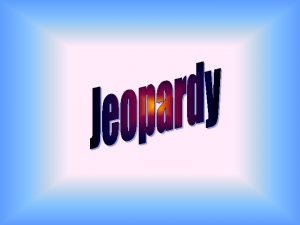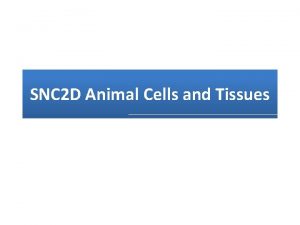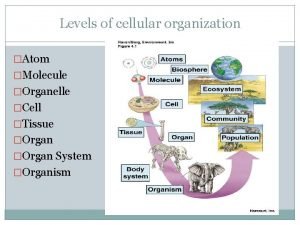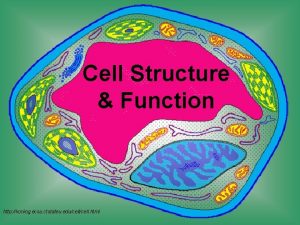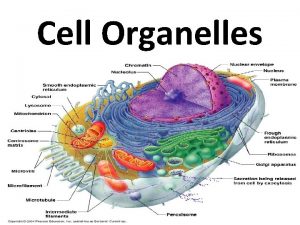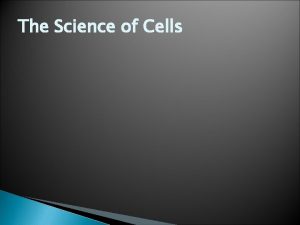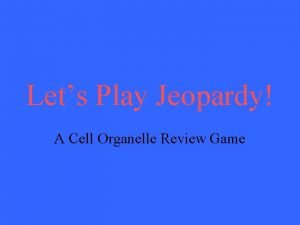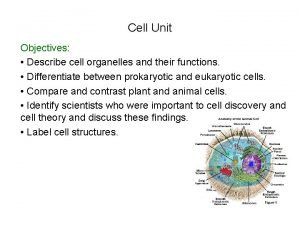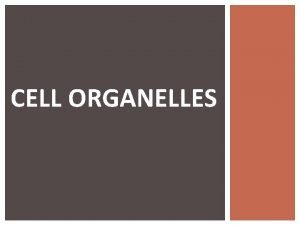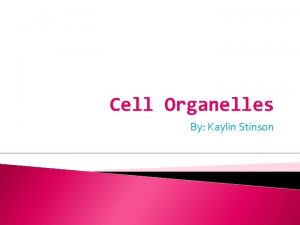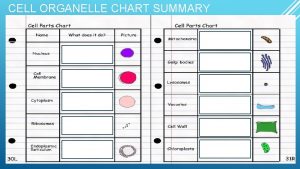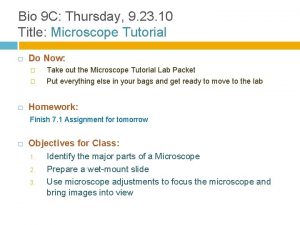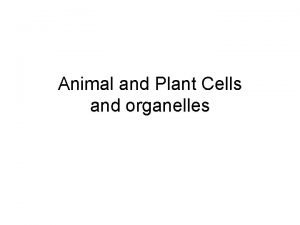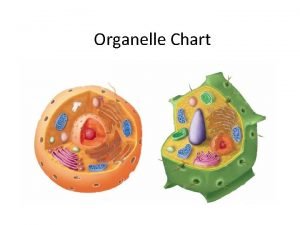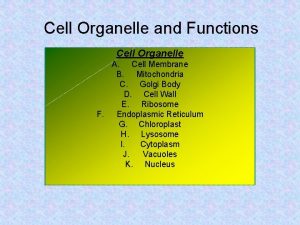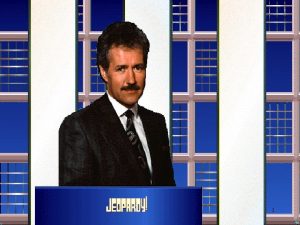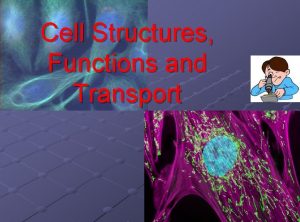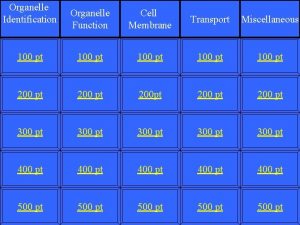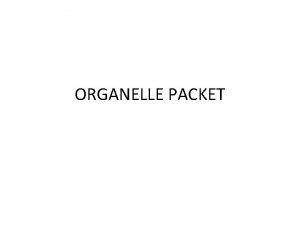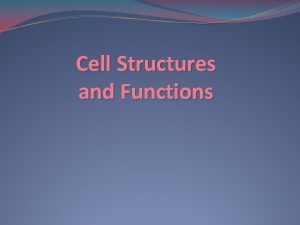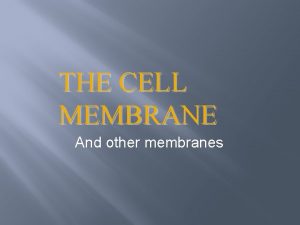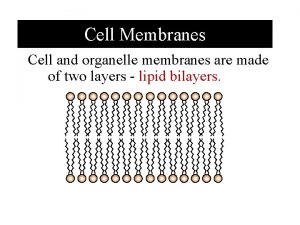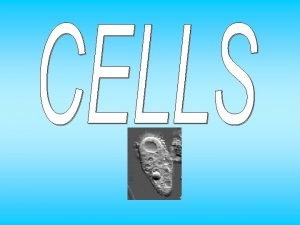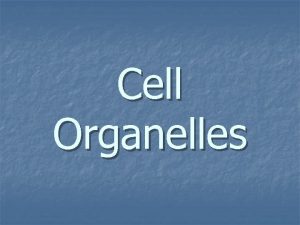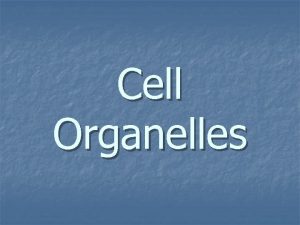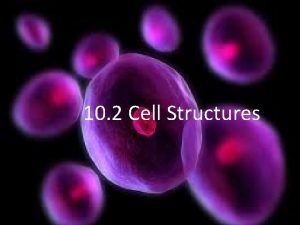Cell Organelle Structures and Functions SC 6 L



















- Slides: 19

Cell Organelle Structures and Functions SC. 6. L. 14. 4 Compare and contrast the structure and function of major organelles of plant and animal cells, including cell wall, cell membrane, nucleus, cytoplasm, chloroplasts, mitochondria, and vacuoles. ESSENTIAL QUESTION: What organelles can only be found in plant cells and what do they do?

Bell Ringer

Discovery Education: Parts of a Cell

I Do- Guided Notes

The Nucleus l Function: Control center of the cell, holds genetic information (DNA). l Found: In ALL Eukaryotic Cells (Both Plant and Animal)

Cell Membrane l Function: Allow items to enter/exit the cell. Keeps bad stuff out. l Found: ALL Cells (Plant and Animal)

Cell Wall l Function: Rigid wall helps plants keep their shape, keep badstuff out l Found: PLANTS but not animal cells. l Allows wall. plants to grow tall, like bricks in a

Chloroplasts l Function: To make food (glucose) through photosynthesis. l Found: ONLY in plant cells! l *Chlorophyll (green) absorbs sunlight.

Mitochondria Function: Convert chemical energy stored in glucose into energy (Cellular Respiration) l Found: In ALL Eukaryotic Cells (Plant and Animal) l More mitochondria are found in muscle cells than skin. l

Cytoplasm l Function: Jelly-like material inside the cell membrane. All organelles can be found here. l Found: ALL Cells (Plant and Animal)

Vacuole l Function: Stores water & Transports waste l Found: LARGE in plants, small in animals

Identify the cell parts. Hint: blue arrows are organelles in animals. Yellow arrows are for organelles in plants only. (Click to check your answers)

We Do Collaborative Activity

REVISITING THE BELLRINGER

YOU DO TIME!

You Do Question #1 For her science project, Suzanne made an animal cell using a rectangular shoe box, pipe cleaners, and construction paper. One comment that the teacher made was that Suzanne should not have used a shoe box. Why did the teacher make this comment? a) b) c) d) Animal cell shape is more round than rectangular. Animal cell shape is more like a stop sign than a rectangle. Plant cell shape is more round than rectangular. Plant and animal cells have a similar shape.

You Do Question #2 l Which organelle is nicknamed “the powerhouse” of the cell and generates the cell’s energy-rich molecules? a) b) c) d) Nucleus Chloroplast Mitochondrion Cell Wall

You Do Question #3 Four cells were examined under the microscope. The following table shows the organelles that were identified in each cell. CELL A B C D ORGANELLES INDENTIFIED IN EACH CELL nucleus cell membrane mitochondria cytoplasm nucleus chloroplast large vacuole mitochondria small vacuoles nucleus cell membrane chloroplast mitochondria cell wall nucleus Based on the table above, which of the following is the best conclusion? a) Cells A and B are plant cells. b) Cells B and D are plant cells. c) Only cell B is a plant cell. d) Only cell C is a plant cell.

Exit Slip – Left Side Many scientists claim plants are more complex than animals based on the differences in plant and animal cells. What evidence can scientists use to support their claim?
 Cell graphic organizer filled out
Cell graphic organizer filled out What cell organelle is like lysol spray cleaning the cell
What cell organelle is like lysol spray cleaning the cell Cell graphic organizer
Cell graphic organizer This organelle controls what enters and exits the cell. *
This organelle controls what enters and exits the cell. * Atoms
Atoms Cell membrane
Cell membrane Molecule organelle cell
Molecule organelle cell Cell organelles song
Cell organelles song Garbage collector animal cell organelle
Garbage collector animal cell organelle Riddle cell
Riddle cell Cell organelle webquest
Cell organelle webquest Cell organelle jeopardy
Cell organelle jeopardy 7 parts of a cell
7 parts of a cell Cell organelle
Cell organelle Cell organelle
Cell organelle Cell organelle graphic organizer answer key
Cell organelle graphic organizer answer key Organelle speed dating
Organelle speed dating Animal cell golgi body
Animal cell golgi body Fun facts about vacuoles
Fun facts about vacuoles Organelle trail
Organelle trail



